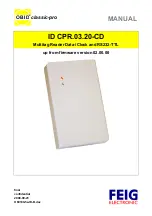
1
SECTION 1. FEATURES AND SPECIFICATIONS
The USB (Universal Serial Bus) Readers are compact magnetic stripe card readers that conform
to ISO standards. In addition to reading multiple tracks of data from a card, the Readers also
include MagnePrint technology. The MagnePrint data will be included with the track data on
each transaction. In order to maximize card security, the Readers incorporate data encryption to
protect the card contents and MagnePrint information. The Readers are compatible with any
device having a host USB interface. A card is read in the swipe readers by sliding it, stripe
down, through the slot either forward or backward; in the insert reader, it is read by inserting
with the stripe to the right or left depending on the head orientation.
An LED (Light Emitting Diode) indicator on the Reader panel provides the operator with
continuous status of the Reader operations.
The readers conform to the USB HID (Human Interface Device) Class specification Version 1.1.
This allows host applications designed for most versions of Windows to easily communicate to
the readers using standard Windows API calls that communicate to the reader through the HID
driver that comes with Windows.
The Readers can be operated in two different modes:
•
HID (herein referred to as “
HID
mode”) and
•
HID with Keyboard Emulation (herein referred to as “
KB
mode”)
When operating in the HID mode, a reader will not use keyboard emulation. It behaves like a
vendor defined HID device so that a direct communication path can be established between the
host application and the reader, without interference from other HID devices.
When configured for the Keyboard Emulation (KB) mode, a Reader emulates a USB HID United
States keyboard or, optionally, any international keyboard using ALT ASCII code keypad key
combinations or customizable key maps. This allows host applications designed to acquire card
data from keyboard input to seamlessly acquire the card data from the USB swipe reader.
Caution
When in Keyboard Emulation mode, if another keyboard is
connected to the same host as the reader and a key is pressed on
the other keyboard while the reader is transmitting, then the data
transmitted by the reader may get corrupted.
When a card is swiped through the Reader, the track data and MagnePrint information will be
TDEA (Triple Data Encryption Algorithm, aka, Triple DES) encrypted using DUKPT (Derived
Unique Key Per Transaction) key management. This method of key management uses a base
derivation key to encrypt a key serial number that produces an initial encryption key which is
injected into the Reader prior to deployment. After each transaction, the encryption key is
modified per the DUKPT algorithm so that each transaction uses a unique key. Thus, the data
will be encrypted with a different encryption key for each transaction.
Содержание 99875388-9
Страница 6: ...vi...
Страница 18: ...USB MagneSafe V5 Swipe and Insert Reader 10...
Страница 25: ...Appendix A Drawings 17 Figure A 2 Mounting Specification for 21063018 and 21063019...
Страница 26: ...USB MagneSafe V5 Swipe and Insert Reader 18 Figure A 3 Mounting Specification for 21063020 and 21063021...
Страница 27: ...Appendix A Drawings 19 Figure A 4 Specification for 21063022...
Страница 28: ...USB MagneSafe V5 Swipe and Insert Reader 20 Figure A 5 Specification for 21063023...










































